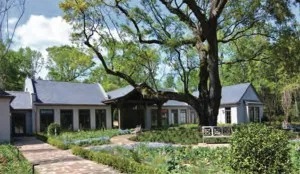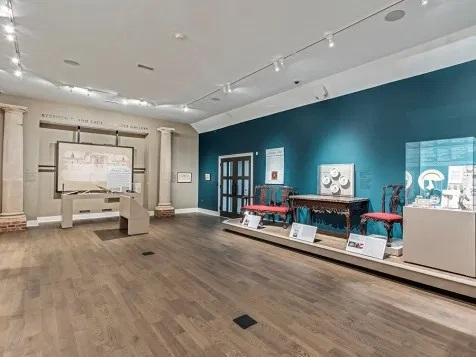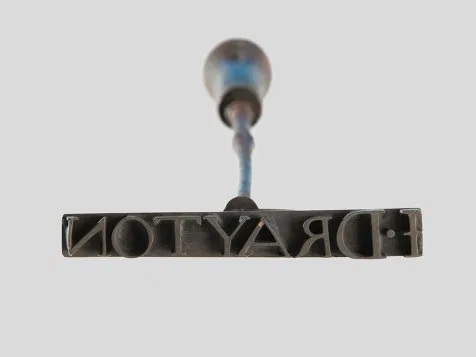A New Chapter for Drayton Hall
Opened this past May, Drayton Hall’s brand new Sally Reahard Visitor Center is the organization’s most visible recent effort to open up the site to visitors. Incorporating the first purpose-built dedicated gallery and exhibit space, easier access to the house and grounds, and active incorporation of the property’s ongoing archaeological excavations, the visitor center brings to light the transformative investigations of the past decade and offers new interpretations based on documentary and archaeological evidence.

The Sally Reahard Visitor Center at Drayton Hall. Image Courtesy of Drayton Hall Preservation Trust.
Built between 1747 and 1752 as a rice and indigo plantation for John Drayton, Drayton Hall descended in the family for seven generations before it was turned over to the National Trust for Historic Preservation. Since opening to the public in 1977 the house has been preserved as an unfurnished architectural relic. Although the family’s possessions have long been scattered to descendants and various museums, ongoing archaeological excavations have helped uncover the material record of early life on the property.
The visitor center’s inaugural exhibit covers the house’s construction and early years. The third son of a prominent family, John Drayton’s early life is largely a documentary blank until his acquisition of the property, but even subsequent records are spotty. For example, in 2014, the dendrochronology of the roof’s support beams proved that the house’s construction began a decade later than previously assumed. Still unknown is how many enslaved workers lived on the property during the earliest years, despite their presence being extensively documented on other similar properties of the era. The exhibit tackles these issues head-on, displaying treasures such as the earliest known architectural rendering of Drayton Hall, thought to have been made by John Drayton himself, archaeological finds, and the uncomfortable history of slavery on the site. The most unexpected, and disturbing, object currently on view is a silver slave brand that would produce the mark “I Drayton.” Although the practice of branding was relatively rare in North America, and there is no written evidence of it with regard to Drayton Hall, this object is proof that the historical traumas of slavery were very real, regardless of whether or not they were documented.
The staff of Drayton Hall is eager to bring a richer experience to visitors going forward. “The heart of this project is the opportunity to display our collection,” says Carter Hudgins, President and CEO of the Drayton Hall Preservation Trust. “Visitors can now expect much more than a tour of the estate.” Likewise, the staff archaeologist and curator of collections Sarah Stroud Clarke looks forward to using the galleries to “delve much more deeply” into stories of the property’s inhabitants from the slaves to John Drayton’s early life.
The Decorative Arts Trust is thrilled to host a one-day symposium in collaboration with Drayton Hall on September 15. “An Agreeable Prospect: Rediscovering Drayton Hall in the 18th-Century Atlantic World” will explore new research about John and Charles Drayton’s cosmopolitan outlook in the colonial era, covering landscape, architecture, and decorative arts. Participants will enjoy in-depth tours and lectures by Drayton Hall staff and renowned experts who assisted in the preservation of the house and reinstallation of the galleries. An optional fundraiser in support of the Trust’s Emerging Scholars Program and Drayton Hall’s Wood Family Fellowship Fund will also take place the night before at the c. 1770 Charles Elliott House in Charleston. The day’s itinerary and registration page can be found here. Please join us for this exciting event!
About The Decorative Arts Trust Bulletin
Formerly known as the "blog,” the Bulletin features new research and scholarship, travelogues, book reviews, and museum and gallery exhibitions. The Bulletin complements The Magazine of the Decorative Arts Trust, our biannual members publication.









